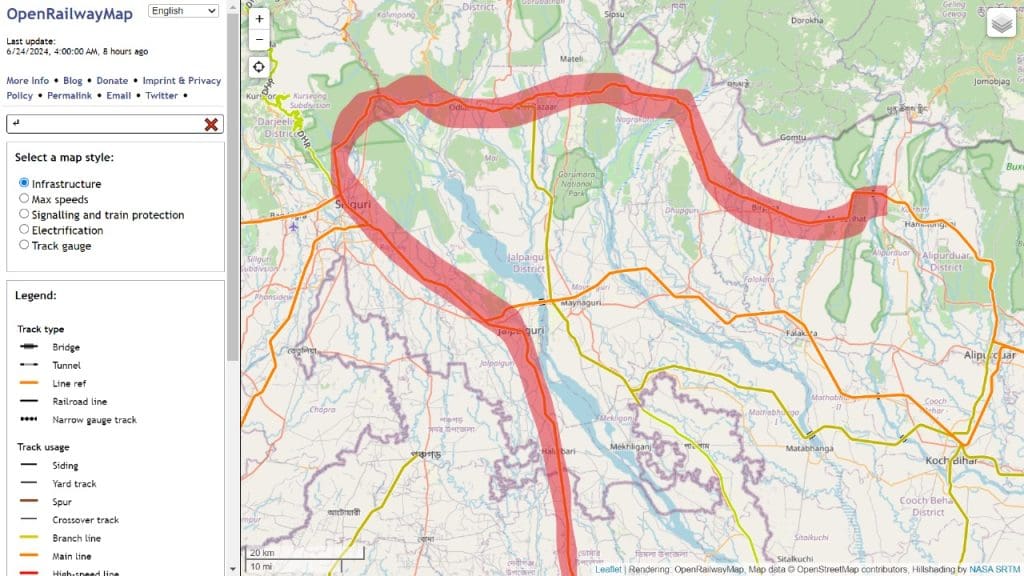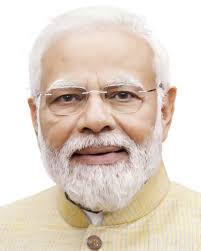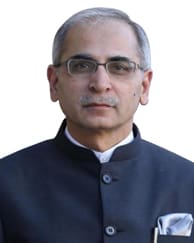Prime Minister Sheikh Hasina landed in New Delhi on 21st June on her bilateral visit, for the second time within the month of June. This historic visit marks the first bilateral visit of any Foreign Head to India since the BJP-led NDA formed the government for the third consecutive term.
The visit reaffirms the neighborhood first policies of both the nations who share monumental affinity in cultural, demographic and economic dynamics and has achieved significant development on the basis of shared benefit in trade, connectivity, and people to people connection.
Prime Minister Narendra Modi received his Bangladeshi counterpart Sheikh Hasina with a ceremonial welcome at the Rashtrapati Bhavan forecourt upon her arrival in the capital, on Saturday. The visit of Sheikh Hasina came at a critical time in South Asian politics where both China and India are placing their cards to emerge as the dominant regional player. Sheikh Hasina is scheduled to visit China in the month of July to discuss critical bilateral issues. Putting the India visit before China, Dhaka aims to shrug off any friction between battling states in Bangladesh’s development journey.
The seven MoUs Signed
Blue Economy
On the Field of Blue Economy and Maritime Cooperation in the Bay of Bengal and India Ocean Region
Oceanography of the Indian Ocean
MoU between Bangladesh Oceanographic Research Institute (BORI) and Council of Scientific and Industrial Research (CSIR) of India for Joint Research on Oceanography of the Indian Ocean and Capacity Building
Rail Connectivity
MoU on Rail Connectivity; and two separate shared visions of India Bangladesh Digital Partnership and shared vision of India Bangladesh Green Partnership for a Sustainable Future. Besides, MoU between Indian National Space Promotion and Authorization Centre (IN-SPACE) and Department of Space, Government of the Republic of India and Ministry of Posts, Telecommunication and Information Technology, Government of Bangladesh was also signed for Collaboration on a Joint Small Satellite Project.
Military Education
A MoU between DSSC, Wellington and DSCSC Mirpur for cooperation concerning military education in the field of strategic and operational studies was also signed.
3 Other MoUs
Three MoUs related to cooperation in the field of fisheries, disaster management; and health and medicine were also renewed.
A Historical Look on the Bangladesh-India Relations
The relationship between the two states was built during the liberation struggle of Bangladesh. To survive brutal Pakistani onslaught millions of Bangladeshis took refuge in India. India and Bhutan were the only nations to recognize Bangladesh much before the Pakistani military surrendered in Dhaka on 16 December, 1971.
After the independence of Bangladesh, the first bilateral summit was held in February, 1972 when Bangabandhu Sheikh Mujibur Rahman and Indira Gandhi met in Calcutta. It was during this summit an agreement on the withdrawal of Indian forces was reached. From a peak strength of 150,000 Indian troops in Bangladesh at the height of the war to a mere 5000 by February,1972. By the 3rd week of march, 1972 all Indian troops withdrew peacefully from Bangladesh. A repatriation agreement of the refugees who fled from Bangladesh to India was also reached during the summit.
On March 17, 1972, Indian Prime Minister Indira Gandhi arrived at Dhaka for the 2nd bilateral summit. The summit concluded with a joint statement which was based on five principles of peaceful Co-existence. On March 19, 1972 Indo-Bangladesh treaty of Peace and Friendship was signed. The treaty signed for a period of 25 years on the basis of lasting peace and friendship, mutual benefit, and no harm was the most comprehensive instrument of hard law to this date in India-Bangladesh relations. Despite relentless efforts of some vested quarters to malign the relations between the two nations without ever having to show anything substantial for much of their criticisms, India-Bangladesh relations have prospered.
People to People Connection
People to people relations between the two states have always been strong despite occasional political tensions rising now and then. Since Sheikh Hasina assumed power in 2009 and Narendra Modi assumed power in 2014 there has been a plethora of efforts to increase these exchanges.
Modi’s visit to Bangladesh in 2015 resulted in increased cultural exchange programs, collaboration in media and entertainment particularly in the Bangla speaking regions. Bangladeshi students are the third largest foreign student community in India according to Indian High Commission, Bangladesh and the number is ever increasing.
0
M
Medical Tourists to India from Bangladesh Annually
Issuance of E-Visa
For medical tourists announced
New Assistant High Commission of India
In Rangpur division
Visa Centers Increased
16 Visa Centers in total
Around 2.5 million Bangladeshi patients go to India every year for medical tourism purposes. While PM Hasina was still in India, the Indian Government has announced the issuance of E-Medical Visa for Bangladeshi patients and new Bus and train connectivity between the two states.
A new Assistant High Commission will be opened in Rangpur Division to cater to the people of the northern region of Bangladesh. The number of visa centers has increased to 16 to facilitate the ever growing number of Bangladeshi visitors to India. Although as much as Bangladeshi tourists visiting India, the same cannot be said for Indian tourists.
Our tourism sector lacks infrastructure and amenities for International tourists and thus we are losing opportunities to earn much needed foreign currencies. If through specific interventions Bangladesh can attract Indian, Bhutanese and Nepalese tourists as it is imperative for our tourism sector since land route connections are being realized between these States we will achieve a circular economy among south asian states.
Growing Economic Relations
In the joint communique Bangladesh and India have agreed to start negotiations on the much anticipated Comprehensive Economic Partnership Agreement(CEPA). According to people familiar with the development, both sides want to complete negotiations by 2026 aligning with Bangladesh’s LDC graduation.
India is Bangladesh’s second largest trading partner. Bilateral trade between the countries has reached around 20 billion USD with Bangladesh exporting around 2 billion USD per annum. Experts observed that the CEPA would offset some of Bangladesh’s post LDC challenges.
Status Quo of Bilateral Trade
0
B
Annual Bilateral Trade
US$ 2 Billion
Bangladesh’s Exports to India
Outcomes of CEPA
0
%
Increase in Bangladesh’s Export
300% Increase
In Bangladesh’s export to India possible if transaction costs are decreased
US$ 5-7 Billion
Bangladesh’s exports to India projected to increase
1.72% Increase
In Bangladesh’s GDP
188% Increase
In India’s exports to Bangladesh
Payment in Local Currencies
RuPay in Bangladesh and TakaPay in India using UPI
FDI Inflow and Market Expansion
If Bangladesh’s exports to Northeast India can be increased
According to a study by Economist Sanjay Kathuria, Dr. Selim Raihan and Prabir De, CEPA will increase Bangladesh’s exports to India by 190 percent to around 5-7 billion USD. And if trade facilitation measures, transaction costs can be reduced, then there could be an increase of 300%. The study titled “Unlocking Bangladesh-India Trade: Emerging Potential and the Way Forward” also stated that India’s export to Bangladesh will see an upward of 188 percent.
The proposed agreement will increase Bangladesh’s GDP by 1.72 percent while the growth will be 0.03 percent for India. Bangladesh is eyeing similar trade agreements with China which is our largest Trade partner. CEPA will not only remove a multitude of trade barriers but will also increase investment opportunities from India.
Other countries may find investing in Bangladesh to export to India lucrative due to removal of barriers. For example – there is a Japanese interest in investing in manufacturing facilities in Bangladesh to export to the remote Northeast India. Both countries have also agreed to introduce methods to promote payment in local currencies. During a meeting between the premiers an agreement was reached to launch RuPay Card in Bangladesh and TakaPay card in India using the Unified Payments Interface (UPI). This move will facilitate greater ease in cross border transactions and is believed to help the visitors of both countries in paying for goods and services in the host country.
Multimodal Regional Connectivity
One of the key highlights of Bangladesh-India relationship in the last decade has been the gradual opening of both nations to each other and other regional partners through multimodal connectivity initiatives. Bangladesh already provides transhipment facilities to Indian goods at the Chittagong and Mongla Ports for a fee of BDT 220 per ton.
৳
0
Transhipment Fee per Ton
The facility allows shipment of Indian goods to its north-eastern region using Chittagong port. On Sheikh Hasina’s visit, India has agreed to extend the transit facilities for movement of Bangladeshi goods to Nepal and Bhutan through the railway network. Both sides have committed to early operationalization of the BBIN Motor Vehicle Agreement to promote sub-regional connectivity.

A new MOU has been signed on railway connectivity to commence goods-train service from Gede-Darshana through Chilahati-Haldibari up to Hasimara via Dalgaon railhead (as and when operationalized) at the India-Bhutan border.
Energy and Grid Connectivity
Energy cooperation between the states have improved a lot in the last few years. India-Bangladesh friendship diesel pipeline stands as a testament to growing partnership between the nations to achieve energy security. Both countries have agreed to expand power and energy collaboration and develop intra-regional energy trade between BBIN nations.
Hydroenergy Imports from Nepal
0
MW
Hydroenergy Import from Nepal
US$ 0.065 Unit Cost
Per kWh
For 25 Years
Lifetime of the Agreement
Much of the hurdle has been lifted to facilitate power purchase from Nepal through Indian territory. The Indian side has agreed to expedite the construction of 765 kV high-capacity interconnection between Katihar-Parbatipur-Bornagar with suitable Indian financial assistance. Private players from both countries are exploring options to establish more oil pipelines.
India has emerged as a secondary source of cheap Russian gas and oil in recent times. They have also managed to bypass western sanctions while trading with Iran, Russia and Venezuela. With more energy connectivity projects Bangladesh can reap benefits from this while reducing risks of western sanctions.
Cooperation on Frontier Technologies
In order to address the growing use of technologies in building an inclusive, sustainable and digitally empowered societies, both the countries have formulated a future oriented partnership through a “Shared Vision for India-Bangladesh Digital Partnership” and “Shared Vision for India-Bangladesh Green Partnership for a Sustainable Future” in line with the countries respective broader Vision of “Viksit Bharat 2047” and “Smart Bangladesh Vision 2041”.
An MOU has been signed between Indian National Space Promotion and Authorization Centre (IN-SPACE) and Department of Space, Government of the Republic of India and Ministry of Posts, Telecommunication and Information Technology, Government of Bangladesh was also signed for Collaboration on a Joint Small Satellite Project.
Defense Cooperation and Maritime affairs
Prime Minister Sheikh Hasina and her Indian counterpart have moved to bolster defense ties between the two nations as both the heads have signed a number of agreements on cooperation in maritime security, ocean research, space and telecommunication. A MoU between Defence Services Stuff College, Wellington and Defence Services Command and Stuff College, Mirpur for cooperation concerning military education in the field of strategic and operational studies was signed. Prime Minister Modi welcomed Bangladesh’s decision to join the Indo-Pacific Ocean Initiative for a shared vision of a free, prosperous and open Indo pacific.
“Bangladesh is situated at the confluence of our Neighbourhood First Policy, Act East Policy, Vision Sagar and Indo-Pacific Vision. In the last one year, we have together completed many important projects of public welfare…Trade in Indian Rupees has started between the two countries”

Narendra Modi
In a Joint Statement
Since the United States put its focus on the indo-pacific region Bangladesh has become a hotbed of geopolitical rivalry due to its geographical position in the Bay of Bengal. While Bangladesh has unveiled its own Indo-Pacific Outlook it seems that the Sheikh Hasina led administration is committed to safeguarding the Indo-Pacific region with its regional peers.
“Bangladesh is a key part of India’s SAGAR Doctrine(Security and Growth for All in the Region) and the Indo-Pacific vision. The renewal of the MOU on maritime cooperation and blue economy that was signed in exchange earlier today aims to develop our ocean based blue economy and maritime cooperation”

Vinay Kwatra
Foreign Secretary of India
While briefing the media on Sheikh Hasina’s visit the Indian Foreign Secretary Vinay Kwatra said the MOU on oceanography will establish a framework for research in that area. Both Bangladesh and India share a maritime boundary in the Bay of Bengal. Both countries settled their maritime dispute in the Permanent Court of Arbitration in the year 2014. Bangladesh lacks the tools and knowledge to effectively utilize its vast maritime area of 1,18,813 sq km.
0
Sq.km
Bangladesh’s Maritime Boundary
The MOU between Bangladesh Oceanographic Research Institute (BORI) and Council of Scientific and Industrial Research (CSIR) of India for Joint Research on Oceanography of the Indian Ocean and Capacity Building will strengthen response and capacity building in the entire domain of disaster risk and mitigation. Our maritime economy offers a lot of promise to boost our national economy and employment and at the same time Bangladesh is also one of the most vulnerable nations against ocean borne natural disasters. Cooperation with nations with a proven track record on maritime management will be crucial in developing the necessary skill and expertise for the Ocean economy and most importantly sustaining it.
Teesta Water Management
One of the biggest hiccups in otherwise a grand and prosperous relation is the issue of water sharing of the Ganges. The Teesta water sharing treaty is set to expire in 2026. An interim agreement that was due to be signed in 2011 failed due to opposition from the West Bengal Chief Mamata Banarjee.
Fearing an unlikely agreement, Bangladesh moved with an ambitious Teesta river management project estimated to be around 1 billion USD. Despite China showing interest in funding the project, considering the sensitivity of this issue to New Delhi, Dhaka decided to move slowly on the project.
During the Joint statement PM Modi has announced a technical team to be sent to Bangladesh to discuss Teesta water conservation. This development was anticipated as recently Indian Foreign secretary Vinay Kwatra on his visit to Dhaka expressed his country’s interest to finance the Teesta water management project.
“We welcome the formation of a Joint Technical Committee to initiate discussions for the renewal of the Ganges Water Sharing Treaty of 1996. As part of our development cooperation, we will also undertake conservation and management of Teesta River inside Bangladesh with Indian assistance within a mutually agreed time frame.”

Narendra Modi
In a Joint Statement
Concluding Remarks
Prime Minister Sheikh Hasina’s visit to India has been part of the series of high level bilateral visits of top officials of both countries in the last decade. The relationship between both nations have undoubtedly progressed and has benefited the people of both sides of the border. This visit is poised to take the multi-faceted relationship on a strategic level as both countries have agreed to increase cooperation on defense and security and have pretty much aligned themselves on the Indo pacific region.
The joint statement did not document the issue of border killing which has been an important domestic issue in Bangladesh as the Bangladeshi side has been calling for use of non-lethal weapons on the border. From the agreements signed and the current political climate in both countries it is safe to say that economic and political cooperation between the nations will deepen further.
It remains to be seen what the joint technical committee will assess about the Teesta issue as it is one of the major domestic and bilateral talking points between Dhaka and New Delhi. Prime Minister Hasina will visit China next month and the river management proposal of China and Bangladesh’s strategies in the Indo-pacific region is believed to be discussed.
The premier is perhaps navigating the most important strategic maneuver in the history of Bangladesh’s foreign affairs through striking a delicate balance between two regional superpowers and multiple global players. She has thus far managed to bring rival regional and global peers to join in her vision of a Developed country status by 2041 while slowly transitioning from a nonalignment strategy to multi-alignment one by fostering bilateral and multilateral collaboration.
About the Author

Tanmoy Dhar is an Economics graduate from the University of Dhaka. He has served an associate at CounterFoto- A Center for Visual Arts.
1 comment
[…] forming the Government in January for a consecutive 4th time. The visit comes just weeks after her state visit to India where Bangladesh and India have taken significant steps in the domain of security, connectivity in […]